ART NOUVEAU
- توضیحات
-
منتشر شده در دوشنبه, 30 -3443 03:25
-
نوشته شده توسط سپیده آبیده
-
بازدید: 2333
Art Nouveau
Staircase of the Maison& Atelier of Victor Horta. This building is one of four Horta-designed town houses in Brussels that are together recognised by UNESCO as "representing the highest expression of the influential Art Nouveau style in art and architecture."[1]
A shop in Porto, Portugal, in Art Noveau style and covered in azulejos.
Art Nouveau (French pronunciation: [aʁnuvo], Anglicised to /ˈɑrt nuːˈvoʊ/) is an international movement[2] and style of art, architecture and applied art—especially the decorative arts—that peaked in popularity at the turn of the 20th century (1890–1905).[3] The name "Art Nouveau" is French for "new art". It is also known as Jugendstil, German for "youth style", named after the magazine Jugend, which promoted it, and in Italy, Stile Liberty from the department store in London, Liberty & Co., which popularised the styleA reaction to academic art of the 19th century, it is characterized by organic, especially floral and other plant-inspired motifs, as well as highly stylized, flowing curvilinear forms.[4] Art Nouveau is an approach to design according to which artists should work on everything from architecture to furniture, making art part of everyday life.[5]The movement was strongly influenced by Czech artist Alphonse Mucha, when Mucha produced a lithographed poster, which appeared on 1 January 1895 in the streets of Paris as an advertisement for the play Gismonda by Victorien Sardou, starring Sarah Bernhardt.[6] It was an overnight sensation, and announced the new artistic style and its creator to the citizens of Paris. Initially called the Style Mucha, (Mucha Style), this soon became known as Art Nouveau.[7]Art Nouveau's fifteen-year peak was most strongly felt throughout Europe—from Glasgow to Moscow to Madrid—but its influence was global. Hence, it is known in various guises with frequent localised tendencies.[8] In France, Hector Guimard'smetro entrances shaped the landscape of Paris and Emile Gallé was at the center of the school of thought in Nancy. Victor Horta had a decisive impact on architecture in Belgium.[9] Magazines like Jugend helped spread the style in Germany, especially as a graphic artform, while the Vienna Secessionists influenced art and architecture throughout Austria-Hungary. Art Nouveau was also a movement of distinct individuals such as Gustav Klimt, Charles Rennie Mackintosh, Alphonse Mucha, René Lalique, AntoniGaudí and Louis Comfort Tiffany, each of whom interpreted it in their own individual manner.[10][11]Although Art Nouveau fell out of favour with the arrival of 20th-century modernist styles,[12] it is seen today as an important bridge between the historicism of Neoclassicism and modernism.[11] Furthermore, Art Nouveau monuments are now recognized by UNESCO on their World Heritage List as significant contributions to cultural heritage.[13] The historic center of Riga, Latvia, with "the finest collection of art nouveau buildings in Europe", was inscribed on the list in 1997 in part because of the "quality and the quantity of its Art Nouveau/Jugendstil architecture",[14] and four Brussels town houses by Victor Horta were included in 2000 as "works of human creative genius" that are "outstanding examples of Art Nouveau architecture brilliantly illustrating the transition from the 19th to the 20th century in art, thought, and society".[1]
Naming the style
At its beginning, neither Art Nouveau nor Jugendstil was the common name of the style but was still known as this in some locations, and the style adopted different labels as it spread between artistic centres.[15]Those two names came from, respectively, Samuel Bing's gallery Maison de l'Art Nouveau in Paris and the magazine Jugend in Munich,[11] both of which promoted and popularised the style.[15]Maison de l'Art Nouveau (House of New Art) was the name of the gallery opened in 1895 by the Germanart dealerSamuel Bing in Paris that marked his exclusive focus on modern art.[16][17] The fame of his gallery was increased at the 1900 Exposition Universelle, where he presented coordinated—in design and color—installations of modern furniture, tapestries and objets d'art.[17] These fully realiseddecorative displays became so strongly associated with the style that the name of his gallery subsequently provided a commonly used term for the entire style: Art Nouveau.[17]

This front cover of an 1896 edition of the German magazine Jugend is decorated in Art Nouveau motifs. Jugend was strongly
associated with the style and the magazine's name inspired the German term for the movement, Jugendstil ("Jugend"-style).
Jugend and Jugendstil
Jugendstil typography, applied to a brewery sign
Jugend: MünchnerillustrierteWochenschriftfürKunst und Leben (English: Youth: the illustrated weekly magazine of art and lifestyle of Munich) was a magazine founded in 1896 by Georg Hirth.[18] At the height of Art Nouveau, the magazine was instrumental in promoting the style in Germany. As a result, its name was adopted as the most common German-language term for the movement: Jugendstil ("Jugend-style"), although, in the early 20th century, the word was applied to only two-dimensional examples of the graphic arts,[19] especially the forms of organic typography and graphic design found in and influenced by German-magazines like Jugend, Pan, and Simplicissimus. It is now applied to the broader manifestations of Art Nouveau visual arts in Germany, the Netherlands, the Baltic states, and Nordic countries.[11][20]
Other names
Other local names were associated with the characteristics of its forms, its practitioners and their works, and schools of thought or study where it was popular. Many of these terms refer to the idea of "newness". Before the term "Art Nouveau" became de rigueur in France, le style moderne ("the modern style") was the more frequent designation.[15]Arte joven ("young art) in Spain, Arte nuova ("new art") in Italy, and Nieuwekunst ("new art") in the Netherlands, модерн ("new", "contemporary") in Russia - all continue this theme.[11] In similar manner, its modern characteristics gave way to the label of CatalanModernisme in Barcelona. Many names refer specifically to the organic forms that were popular with the Art Nouveau artists: Stile Floreal ("floral style"), Lilienstil ("lily style"), Style Nouille ("noodle style"), Stile Vermicelli ("vermicelli", or "little worm noodle" style), Bandwurmstil ("tapeworm style"), Paling Stijl ("eel style"), and Wellenstil ("wave style").[15]
In other cases, important examples, well-known artists, and associated locations influenced the names. Hector Guimard's Paris Métro entrances, for example, provided the term Style Métro, the popularity in Italy of Art Nouveau designs from London's Liberty & Co department store resulted in its being known as the Stile Liberty ("Liberty style"), and, in the United States, it became known as the "Tiffany style" due to its connection to Louis Comfort Tiffany.[11][15] In Austria, a localized form of Art Nouveau was practised by artists of the Vienna Secession, and it is, therefore, known as the Sezessionstil ("Secession style").[21] As a stand-alone term, however, "Secession" (German: Sezession, Hungarian: szecesszió) is frequently used to describe the general characteristics of Art Nouveau style beyond Vienna, but mostly in areas within the cultural reach of Austria-Hungary at the turn of the 20th century. In the United Kingdom, it is associated with the activities of Charles Rennie Mackintosh in Glasgow, and is often known as the "Glasgow" style.Art Nouveau tendencies were also absorbed into larger local movements. In Denmark, for example, it was one aspect of Skønvirke ("aesthetic activity"), which itself more closely relates to the Arts and Crafts Movement.[22][23] Likewise, artists adopted many of the floral and organic motifs of Art Nouveau into the MłodaPolska ("Young Poland") movement in Poland.[24]MłodaPolska, however, was also inclusive of other artistic styles and encompassed a broader approach to art, literature and lifestyle.[25]
The book-cover by Arthur Mackmurdo for Wren's City Churches (1883) is often cited as the first realisation of Art Nouveau
Origins
The origins of Art Nouveau are found in the resistance of William Morris to the cluttered compositions and the revival tendencies of the Victorian era and his theoretical approaches that helped initiate the Arts and crafts movement.[26] However, Arthur Mackmurdo's book-cover for Wren's City Churches (1883), with its rhythmic floral patterns, is often considered the first realisation of Art Nouveau.[26] Around the same time, the flat perspective and strong colors of Japanese wood block prints, especially those of Katsushika Hokusai, had a strong effect on the formulation of Art Nouveau's formal language.[27] The wave of Japonisme that swept through Europe in the 1880s and 1890s was particularly influential on many artists with its organic forms, references to the natural world, and clear designs that contrasted strongly with the reigning taste.[27] Besides being adopted by artists like Emile Gallé and James Abbott McNeill Whistler, Japanese-inspired art and design was championed by the businessmen Siegfried Bing and Arthur Lasenby Liberty at their stores[28] in Paris and London, respectively.[27]
Character
Although Art Nouveau took on distinctly localised tendencies as its geographic spread increased—discussed below—some general characteristics are indicative of the form. A description published in Pan magazine of Hermann Obrist's wall-hanging Cyclamen (1894) described it as "sudden violent curves generated by the crack of a whip", which became well known during the early spread of Art Nouveau.[29] Subsequently, not only did the work itself become better known as The Whiplash, but the term "whiplash" is frequently applied to the characteristic curves employed by Art Nouveau artists.[29] Such decorative "whiplash" motifs, formed by dynamic, undulating, and flowing lines in a syncopated rhythm, are found throughout the architecture, painting, sculpture, and other forms of Art Nouveau design.
Philosophy and geography
Art Nouveau is now considered a 'total' style, meaning that it encompasses a hierarchy of scales in design — architecture; interior design; decorative arts including jewellery, furniture, textiles, household silver and other utensils and lighting; and the range of visual arts. (See Hierarchy of genres.) In the philosophy of the movement, art should be a way of life.[5] For many Europeans, it was possible to live in an art nouveau-inspired house with art nouveau furniture, silverware, crockery, jewellery, cigarette cases, etc. Artists desired to break all connections to classical times and bring down the barriers between the fine arts and applied arts. Art Nouveau was underlined by a particular way of thinking about modern society and new production methods, attempting to redefine the meaning and nature of the work of art so that art would not overlook any everyday object, no matter how utilitarian. Hence the name Art Nouveau - "New Art".[5]
International expos
A high point in the evolution of Art Nouveau was the Exposition Universelle of 1900 in Paris, which presented an overview of the 'modern style' in every medium. It achieved further recognition at the EsposizioneInternazionaled'ArteDecorativaModerna of 1902 in Turin, Italy, where designers exhibited from almost every European country where Art Nouveau was practised.
Painting and graphic arts
Two-dimensional Art Nouveau pieces were painted, drawn, and printed in popular forms such as advertisements, posters, labels, magazines and the like. Japanese wood-block prints, with their curved lines, patterned surfaces, contrasting voids, and flatness of visual plane, also inspired Art Nouveau. Some line and curve patterns became graphic clichés that were later found in works of artists from all parts of the world.Louis Comfort Tiffany's 1890 window Education
Relationship with contemporary styles and movements
As an art movement, Art Nouveau has affinities with the Pre-Raphaelites and the Symbolist movement, and artists like Aubrey Beardsley, Alphonse Mucha, Edward Burne-Jones, Gustav Klimt and Jan Toorop could be classed in more than one of these styles. Unlike Symbolist painting, however, Art Nouveau has a distinctive visual look; and unlike the artisan-oriented Arts and Crafts Movement, Art Nouveau artists readily used new materials, machined surfaces and abstraction in the service of pure design.Art Nouveau did not negate the machine as the Arts and Crafts Movement did, but used it to its advantage. For sculpture, the principal materials employed were glass and wrought iron, leading to sculptural qualities even in architecture. Ceramics were also employed in creating editions of sculptures by artists such as Auguste Rodin.[40]Art Nouveau architecture made use of many technological innovations of the late 19th century, especially the broad use of exposed iron and large, irregularly shaped pieces of glass in architecture. By the start of the First World War, however, the highly stylised nature of Art Nouveau design—which itself was expensive to produce—began to be dropped in favour of more streamlined, rectilinear modernism, which was cheaper and thought to be more faithful to the rough, plain, industrial aesthetic that became Art Deco.
Art Nouveau
“هنر جدید”
پلکان Maison & Atelier اثر ویکتور هورتا .این بنا یکی از چهار خانه شهری در بروسلز است که همه آنها به عنوان نمایش بالاترین تجلی متنفذ شیوه ی آرت نوا در هنر معماری توسط یونسکو شناخته شد.
آرت نوا یک شیوه و جنبش بین المللی هنر، معماری و هنر کاربردی به خصوص در هنر های تزیینی است که در ابتدای قرن بیستم به اوج محبوبیت خود رسید (1890-1905). آرت نوا یک اسم فرانسوی به معنی هنر جدید است . همچنان این شیوه به عنوان Jugendstil در آلمان به معنی شیوه جوانان مشهور و بعد از مجله Jugend نامگذاری شد که این مجله آن را ترویج داد و در ایتالیا با نام Stileliberty شناخته شد که این نام از یک فروشگاه زنجیره ای در لندن به نام Liberty&Co گرفته شد . به همین ترتیب این نام در کشورهای مختلف ترویج پیدا کرد.
یک عکس العمل به هنر آکادمیک قرن نوزدهم،نوعی تمثال اندامی مانند دنباله شکلهای منهنی به خصوص از نوع گلها و بقیه گیاهان بود که باعث الهام بخش بودن موضوعات می شد. آرت نوا یک را ه رسیدن به طرح مطابق با خواست هنرمندان بود که روی هر چیزی کار می کردند از معماران گرفته تا مبلمان سازها، که این هنر در کلیه وجوه روزمره زندگی به کار گرفته شد.
این جنبش توسط Czech تاثیر بسزایی روی هنرمند آلفونسو موکا گذاشت . موکا یک پوستر چاپ سنگی تولید کرد که دراول ژانویه 1895 در یکی از خیابانهای پاریس به عنوان تبلیغ برای بازی در Gismonda توسط Victorien Sardou در نقش سارا برناردت از آن پرده برداری شد . این یک تاثیر یک شبه بود و یک شیوه هنرمندانه جدید را منتشر کرد و این هنر خلاقانه ای بود برای شهروندان پاریسی. در آغاز این شیوه شیوه موکا نامیده شد و این شیوه خیلی زود به عنوان آرت نوا مشهور شد.
آرت نوا حد اکثر طی پانزده سال در سراسر اروپا گسترش پیدا کرد . از گلاسکو به مسکو و از مسکو به مادرید ، اما این تاثیر جهانی بود . ورودیهای متروی Hector Guimard در فرانسه نمایی از شهر پاریس را با شیوه آرت نوا به نمایش گذاشته است. ویکتور هورتا تاثیر بسزایی در معماری بلژیک گذاشت. مجله هایی مانند Jugend به گسترش این شیوه در آلمان بسیار کمک کردند به خصوص به عنوان یک شکل هنری گرافیک ، به همین صورت Vienna Secessionists در معماری سراسر اتریش موثر بود. آرت نوا جنبشی بود که هر کس به صورت انفرادی و منحصر به فرد آن را معرفی می کرد مثل Gustar Klimt , Charles Rennie Mackintoch , Alphonce Mucha, Rene Lalique Amtoni Jaudi , Louis Comfort tiffany .
اگرچه آرت نوا با رسیدن قرن بیستم و شیوه های مدرنیست اتفاق افتاد امروزه به عنوان پلی مهم ما بین نئو کلاسیزم ، هیستوری سیزم و مدرنیزم مشاهده می شود . از این گذشته اثرات تاریخی آرت نوا توسط یونسکو در فهرست میراث جهانی به عنوان بخشهای عمده میراث فرهنگی به رسمیت شناخته شده است . مرکز تاریخی ریگا و لادویا با بهترین مجموعه بناهای آرت نوا در اروپا در فهرستی در سال 1997 به دلیل کیفیت و کمیت آرت نوا و معماریJugendstil ثبت شد و چهار خانه شهری بروسلز که توسط ویکتور هورتا ساخته شده بود در سال 2000 با عنوان کارهای انسان خلاق و باهوش ثبت شد که اینها نمونه های برجسته از معماری آرت نوا هستند که به خوبی این هنر را از قرن نوزدهم به بیستم در هنر ، تفکر و اجتماع منتقل می کند.
خانه هنر جدید:
خانه هنر جدید اسم گالری بود که در سال 1895 توسط ساموئل بینگ آلمانی در پاریس افتتاح شد که توجه ویژه او را بر روی هنر مدرن نشان می داد . شهرت گالری او در 1900 Exposition Universelle جایی که او هماهنگی در طرح ، رنگ و کاربرد مبلمان و ملیله دوزی مدرن عرضه می کند افزایش پیدا کرد. با تمام اینها می توان فهمید،نمایشهای زینتی با آرت نوا در ارتباط بودند که اسم گالری ساموئل بینگ متعاقبا استفاده ی عادی از این عبارت را برای این شیوه یعنی آرت نوا را میسر می ساخت.این جلد مقابل نمونه ای از مجله ی آلمانی Jugendچاپ سال 1986 است که با موضوع آرت نوا طراخی شده است.Jugend با این شیوه در ارتباط و اسم این مجله الهام بخش این تحول هنری در آلمان بود.
Jugend and Jungedstıl:
(جوانان : مجله ی هفتگی مصورهنروشیوه ی زندگی مونیخ) مجله ای بود که در سال 1896 توسط Georg Hırth یافت شد. این مجله در ترویج این شیوه در آلمان بسیارسودمند بود. در نتیجه این اسمی است که به عنوان عبارتی مشترک در زبان آلمانی برای این تحول هنری پذیرفته شد:("Style -Jugend ")Jugendstıl ، گرچه دراوایل قرن بیستم این عبارت در نمونه های دو بعدی هنر گرافیک به کار برده شد به خصوص در فرمهای اصلی فن چاپ و طراحی گرافیک کشف شد و مجله هایی آلمانی مانند: Pan,Jugnedو Simplicissimus بر روی آنها تاثیر گذاشتند. امروزه به عنوان ظهورهنرهای بصری آرت نوا در آلمان،هلند،ایالات بالتیک وکشورهای شمالی به کار برده می شود.
سایر نامهای آرت نوا یا هنر جدید:
سایر نامهای محلی با فرم ویژه آن،مشاغل وابسته،وکارایی آن ونوع تفکریا مطالعه آن،جاییکه به صورت مردمی درآمد آمیزش پیدا کرد.بیشتر این عبارتها به نظریه تجدد بر می گردد.قبل از اینکه آرت نوادرفرانسه شیوه ای مدرن بشود نقوشی تکراری بود. بسیاری از نامها بر میگردد به شکل های اصلی که توسط هنرمندان آرت نوا معروف شدند مانند:
Stıle Floreal(floral style),Lilienstile(“lily style”),Style Nouille(“noodle style”),Stile Vermicelli(“vermicelli” or “little worm noodle” style),Bandwurmstil(“tapeworm style”),Paling Stijl(“eel style”),and Wellenstill(“wave style”).
در موارد دیگر،مهمترین نمونه ها،هنرمندان مشهورومکانهای مربوطه برروی این نامها تاثیرگذاشتند به عنوان مثال ورودی های مترو Hector Guimard در پاریس شیوه ی مترو را رواج دادندو در ایتالیا شهرت طراحی های آرت نوا از فروشگاههای زنجیره ای Liberty&Co درلندن گرفته شد ودر نتیجه به عنوان Stile Liberty (liberty style) شناخته شد و درآمریکا به دلیل ارتباط با لوییس کامفورت تیفانی به عنوان شیوه ی تیفانی شناخته شد.در اتریش شکل محلی آرت نوا توسط هنرمندانVienna Secession کار می شد وبه عنوان Sezessionstil(“Secession style”) شناخته شد. به عنوان یک شاخصه تک بعدی گرچه انتزاع در آلمان:Sezession و در مجارستان: Szecesszio مکررا برای توضیح شیوه ی آرت نوا استفاده می شد اما در اوایل قرن بیستم بیشتر در ناحیه هایی با فرهنگ برگرفته ازاتریش و مجارستان به دست آمد. در انگستان این موضوع با فعالیت جارلزرنی مکینتاش در گلاسکو مرتبط می شد که اغلب به عنوان شیوه ی گلاسکو شناخته می شد. گرایشات آرت نوا در جنبشهای محلی بزرگترمشاهده می شدند. به عنوان مثال در دانمارک این جنبش یک جنبه ازهنر و زیبایی بود که درون مایه اش بیشتر به محتوا هنر و صنعت نزدیک بود. به علاوه،هنرمندان تعداد زیادی از موضوعات گیاهی و حیوانی از آرت نوای ملودا پولسکا (لهستان جدید) در لهستان بر می گزینند. هرچند ملودا پولسکا شامل سبکهای هنری دیگر نیز هست و نزدیکی زیادی به ادبیات ،هنر و سبک زندگی را داراست.این جلد کتاب اثر آرتور مک موردو برای کلساهای Wern’s City در سال 1883 است که اغلب به عنوان اولین درک ازآرت نوا ذکر می شود.
اصالت آرت نوا یا هنر جدید:
اصالت آرت نوا در پایداری ویلیام موریس در ترکیبهای درهم وبرهم ریخته ودراحیا گرایشهای ویکتوریان ارا کشف و مشی نظری اش در بنیاد نهادن تحول هنر و صنعت کمک کرد. اگرچه جلد کتاب آرتور مک موردوبرای کلیساهای Wern’s City که حاوی پس زمینه ی گلدار است اغلب به عنوان اولین درکار آرت نوا ملاحضه می گردد. در همین زمان،چشم انداز تخت ورنگهای قوی چاپ شده بر روی ستونهای چوبی بخصوص آثارکاتسوشیکاهوکوسای تاثیر قوی بر زبان عادی آرت نواداشت. موج ژاپنی که بین سالهای 1880 تا 1890 در سراسر اروپا به دلیل شکل های طبیعی،منابع طبیعی دنیا و طرحهای واضح که با ذائقه ی سلطنتی تضاد داشتند گسترش پیدا کرد. از طرفی هنرو طرح ژاپنی توسط هنرمندانی مانند:Emıle Galle وJames AbbottMcNeil Whistler با احترام به وسیله ی تجاری مثل : SiegfriedوArthur Lasenby Liberty به اروپا وارد می شد و آنها درفروشگاههایشان واقع در لندن و پاریس ازاین طرحها حمایت می کردند.
نهاد آرت نوا یا هنر جدید:
به طور قطع این تمایل محلی با گسترش جغرافیایی بالا رفت. شرحی که در مجله ی هرمن اوبریست به چاپ رسیده اینگونه توضیح داده است که (خشونت ناگهانی مولود تحول ناگهانی است)که در دوران پیشرفت اولیه آرت نوامشهورشد. متعاقبا نه تنها این کار به خودی خود به تحول ناگهانی مشهور شد بلکه این تحول ناگهانی بارها توسط هنرمندان آرت نوا مورد استفاده قرار گرفت.
جغرافی و فلسفه در آرت نوا یا هنر جدید:
امروزه آرت نوا به عنوان شیوه ی کلی مورد نظر است به این معنی که این شیوه شامل سلسه مراتب مقیاس درطراحی،معماری،معماری داخلی و هنرهای تزیینی که شامل جواهرات،مبلکان،منسوجات،وسایل نقره ، سایر ظروف ، چراغها و حوزه هنرهای بصری است. در فلسفه این تحوال هنر باید راه زندگی باشد. برای بسیاری از اروپاییان این امکان وجود داشت که در خانه های الهام گرفته از هنر آرت نوا که وسایل این خانه ها از مبلمان ،جواهرات،ظروف نقره گرفته تا جعبه ی سیگار همهگی با ایده ای از ارت نوا ساخته شده بود زندگی کنند. هنرمندان می خواستند هر چیزی که به دوران کلاسیک مربوط می شد را از بین ببرند و سد بین هنر عالی و هنر کاربردی را کاهش دهند. ارت نوابا روش خاص فکری در مورد جامعه ی مدرن و روشهای تولید جدید تلاش کردوبر تعریف دوباره ی هنر و طبیعت کار هنرتاکید داشت بنابراین دنیای هنر با اینکه اسمش آرت نوا بود بر روی مسایل روزمره و اینکه جطورسودمندگرا هستند اشرافی نداشت.
نمایش بین المللی آرت نوا یا هنر جدید:
امتیاز ویژه ی سیر تکاملی ارت نوادرشهر پاریس سال 1900 درExposition Universelle بود که نمای کلی شیوه ی مدرن را عرضه کرد. یکبار دیگرآرت نوادرExposizioneInternazionale d’lArte Decorativa Moderna سال 1902در شهر تورین ایتالیا به رسمیت شناخته شد جاییکه هنرمندان تقریبا از همه جای کشورهای اروپایی هر آنچه را که از آرت نوا یاد گرفته بودند به نمایش گذاشتند.
نقاشی و هنر گرافیک درآرت نوا یا هنر جدید:
نمونه های دوبعدی آرت نوا به صورتهای مختلفی مثل :تبلیغات،پوسترها،برچسب هاو مجلات نقاشی، طراحی وچاپ می شدند. ستونهای چوبی چاپی ژاپنی با خطهای منحنی،سطوح الگویی،تضاد تهی،سطوح مسطح بصریشان از ارت نوا الهام گرفتند. چندین و پیش زمینه های منحنی کلیشه های گرافیکی شدند که بعدها در اثار هنرمندان جهان کشف شدند.
ارتباط با شیوه های معاصر و جنبش ها:
آرت نوا به عنوان یک تحول هنری با دوره رافائلیست و سمبولیست پیوستگی دارد وهنرمندانی مانند Aubrey eardsley ,Alphonse Mucha ,Edward Burne-jones ,Gustav Klimt و Jan Toorop می توانند به بیشتر از یک روش طبقه بندی شوند. برخلاف نقاش نمادگر،آرت نوا همچنان دید مشخصی دارد و برخلاف صنعتگران تحول هنر و صنعت مشرق زمین ،هنرمندان آرت نوا به راحتی از مواد جدید،سطوح ماشینی و انتزاع در طرح های خود استفاده می کردند.
آرت نوا صنعت ماشینی را مثل تحول هنر و صنعت نفی نمی کرد اما از مزایای آن استفاده می کرد. مواد اصلی که در مجسمه سازی استفاده می شدند شیشه و آهنهای شکل دار بودند که در کیفیت مجسمه ها و حتی معماری نقش عمده داشتند. همچنین سرامیک در ساختن مجسمه ها توسط هنرمندانی مانند:Auguste Rodin به کار گرفته می شد.معماری آرت نوا با استفاده از نو آوری فنی در اواخر قرن نوزدهم به وجود آمد به خصوص اینکه ازآهن های بزرگ و عریض و تکه های شیشه نامتناسب درمعماری استفاده می شد.با شروع جنگ جهانی اول گرچه طبیعت طراحی ارت نوا در جایگاه ویژه ای بود وتولید آن بسیار گزاف بود وخیلی ساده شروع به سقوط و چون خطوط مستقیم مدرنیسم بسیار ارزانتر و به مراتب پهن و ناهموار بودند به جای طرحهای آرت نوا استفاده شد و ظریف کاری صنعتی به شیوه ی آرت نوا دکور شد.
به منظور درج نظر برای این مطلب، با نام کاربری و رمز عبور خود، وارد سایت شوید.


 دانشگاه جامع علمی کاربردی
دانشگاه جامع علمی کاربردی
 موسسه آموزش عالی فرهنگ و هنر
موسسه آموزش عالی فرهنگ و هنر
 مرکز آموزش 13 تهران
مرکز آموزش 13 تهران
 اخبار
اخبار
 مشاوره
مشاوره
 امور تربیت بدنی
امور تربیت بدنی
 هماورد مهارتی
هماورد مهارتی
 اخبار فرهنگی
اخبار فرهنگی
 آئین نامه انضباطی
آئین نامه انضباطی
 نشریات دانشجویی
نشریات دانشجویی
 اتاق خبر 13
اتاق خبر 13
 همایش و سمینار
همایش و سمینار
 گالری
گالری
 دانشجویان کارآفرین
دانشجویان کارآفرین
 فرمهای مرکز
فرمهای مرکز
 فرم دریافت مشخصات مدرس
فرم دریافت مشخصات مدرس
 فرم دروس پیشنهادی نیمسال دوم
فرم دروس پیشنهادی نیمسال دوم
 فرم های خام برنامه ریزی درسی
فرم های خام برنامه ریزی درسی
 فرم پیش ثبت نام
فرم پیش ثبت نام
 فرم درخواست گواهی اشتغال به تحصیل
فرم درخواست گواهی اشتغال به تحصیل
 فرم دفترنظارت و بازرسی
فرم دفترنظارت و بازرسی
 فرم شورای آموزش
فرم شورای آموزش
 فرم معرفی به استاد
فرم معرفی به استاد
 فرم درخواست ریزنمرات
فرم درخواست ریزنمرات
 فرم ثبت نام در رشته های ورزشی
فرم ثبت نام در رشته های ورزشی
 فرم درخواست صدور کارت دانشجویی المثنی
فرم درخواست صدور کارت دانشجویی المثنی
 فرم درخواست تجدید نظر در نمره
فرم درخواست تجدید نظر در نمره
 فرم اعلام مشکل مالی
فرم اعلام مشکل مالی
 فرم اعلام دروس افتاده
فرم اعلام دروس افتاده
 فرم مخصوص دانشجویان کارشناسی
فرم مخصوص دانشجویان کارشناسی
 فرم درخواست تغییر رشته
فرم درخواست تغییر رشته
 فرم درخواست معرفی نامه جهت دروس عملی
فرم درخواست معرفی نامه جهت دروس عملی
 فرم ثبت نام در انجمن علمی دانشجویی
فرم ثبت نام در انجمن علمی دانشجویی
 عضویت در انجمن علمی و کانون های مرکز 13
عضویت در انجمن علمی و کانون های مرکز 13
 فرم درخواست تک پودمان
فرم درخواست تک پودمان
 فرم درخواست تک درس
فرم درخواست تک درس
 فرم کدرهگیری دانش آموختگان
فرم کدرهگیری دانش آموختگان
 فرم شرکت در مسابقه عکاسی
فرم شرکت در مسابقه عکاسی
 فرم پذیرش ایده در رویداد ایده تاپ
فرم پذیرش ایده در رویداد ایده تاپ
 فرم پذیرش میهمان
فرم پذیرش میهمان
 گزارش آموزش مجازی
گزارش آموزش مجازی
 فرم درخواست کارورزی
فرم درخواست کارورزی
 فرم اولیه ثبت ایده
فرم اولیه ثبت ایده
 ثبت نام در سایت
ثبت نام در سایت
 قوانین و مقررات
قوانین و مقررات
 آرشیو خبری
آرشیو خبری
 نقشه سایت
نقشه سایت
 آموزش های ویدیویی نحوه کار با سایت
آموزش های ویدیویی نحوه کار با سایت
 سوالات متداول
سوالات متداول
 راهنمای ارسال تیکت
راهنمای ارسال تیکت
 ارتباط با حوزه ریاست
ارتباط با حوزه ریاست
 ارتباط با مدیران گروه ها
ارتباط با مدیران گروه ها
 ارتباط با پرسنل دانشگاه
ارتباط با پرسنل دانشگاه
 ارتباط با مشاوران دانشگاه
ارتباط با مشاوران دانشگاه
 ارسال تیکت
ارسال تیکت
 تیکت های من
تیکت های من











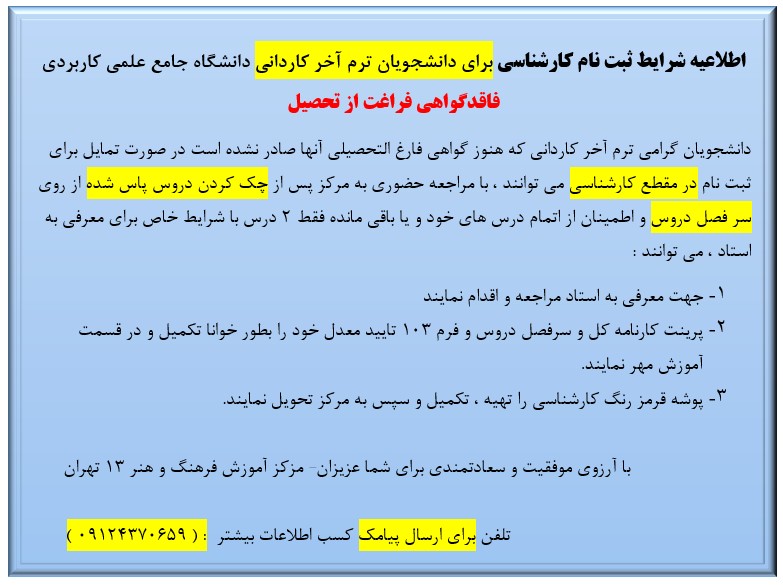
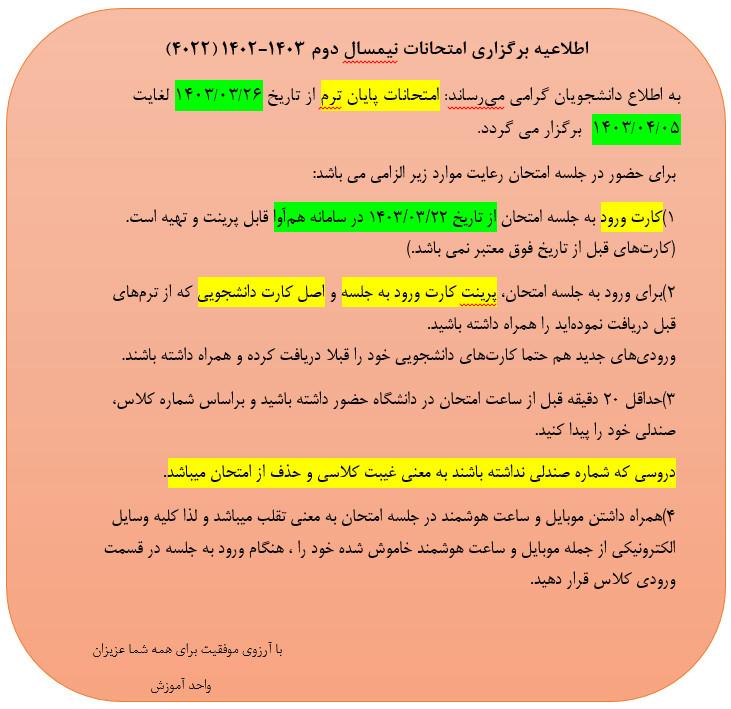
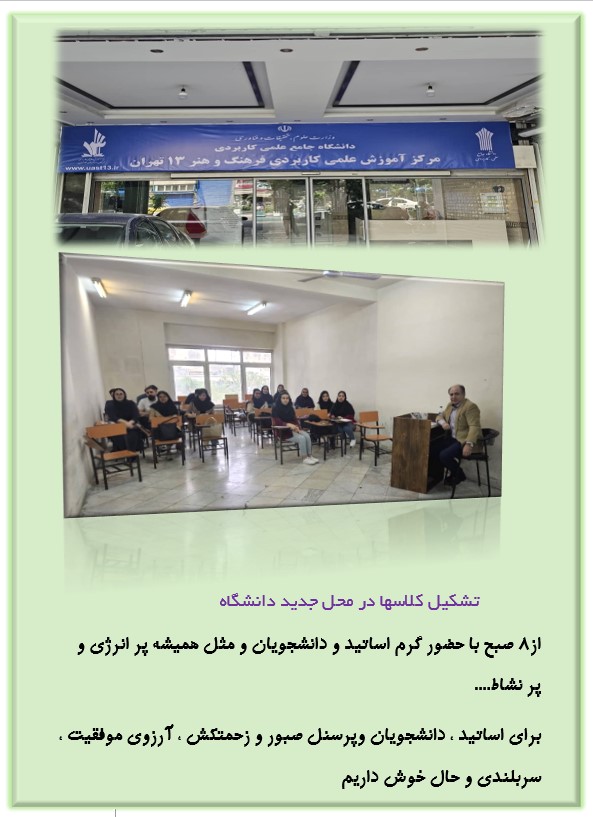
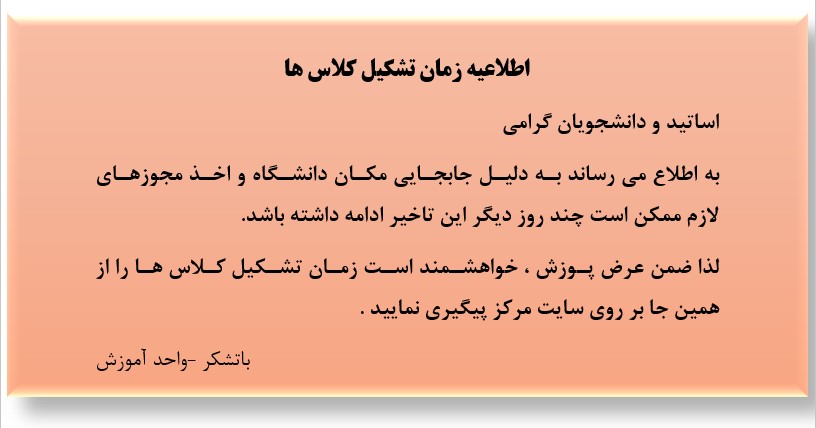
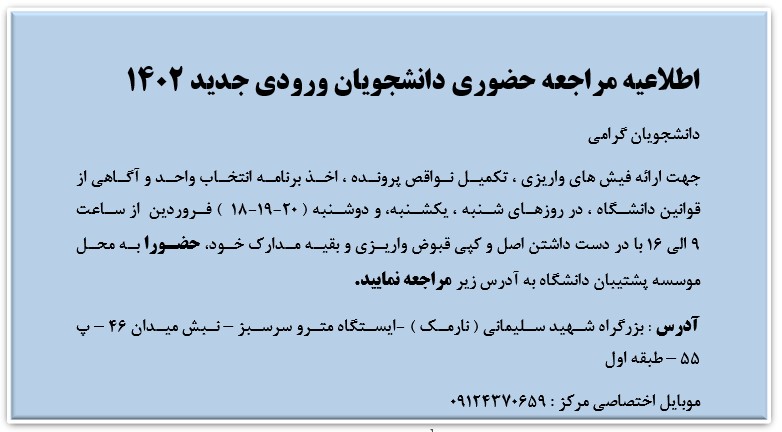
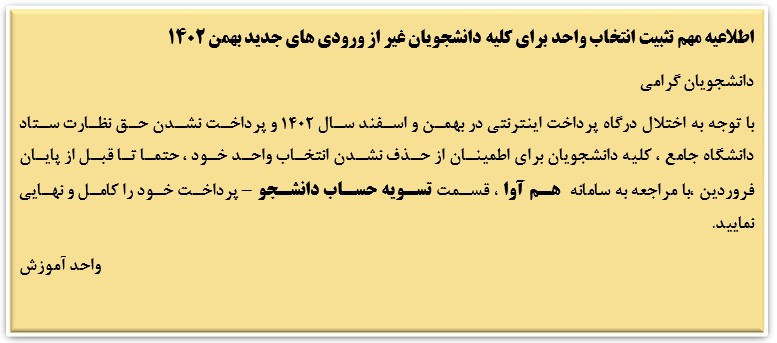
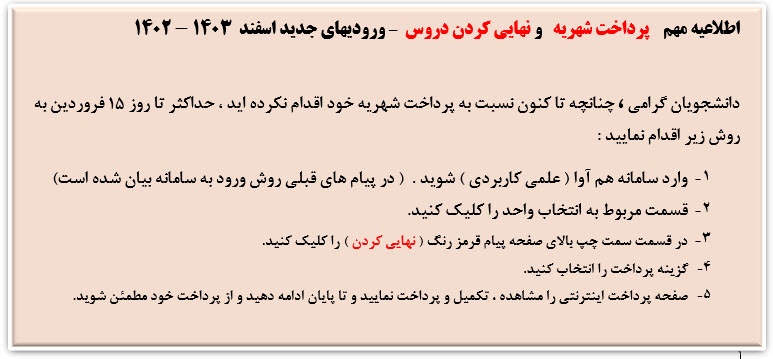
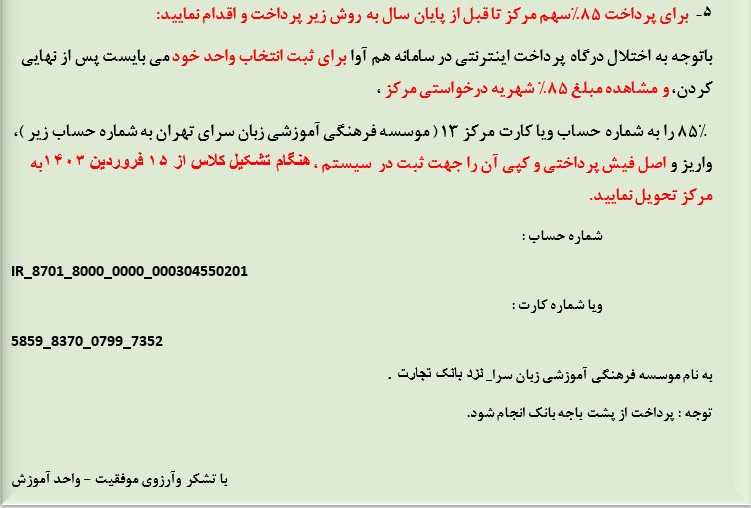
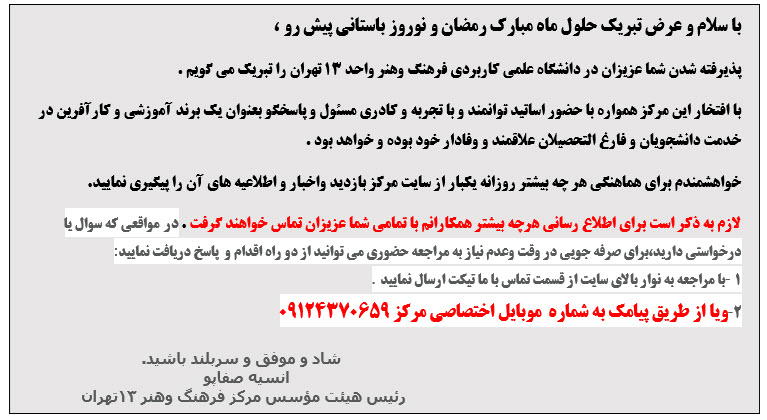





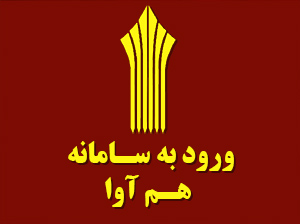

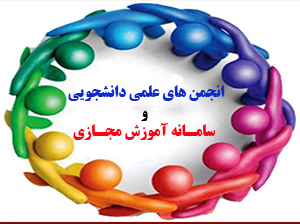











































نظرات